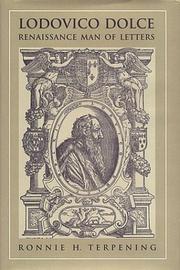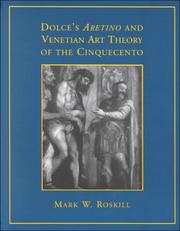| Listing 1 - 8 of 8 |
Sort by
|
Book
Year: 1995 Publisher: Bergamo Centro di studi tassiani
Abstract | Keywords | Export | Availability | Bookmark
 Loading...
Loading...Choose an application
- Reference Manager
- EndNote
- RefWorks (Direct export to RefWorks)
Book
ISBN: 2252030607 9782252030608 Year: 1996 Volume: 21 Publisher: Paris: Klincksieck,
Abstract | Keywords | Export | Availability | Bookmark
 Loading...
Loading...Choose an application
- Reference Manager
- EndNote
- RefWorks (Direct export to RefWorks)
kunsttheorie --- schilderkunst --- Dolce, Lodovico --- Painting, Renaissance --- History. --- Painting --- Early works to 1800 --- painting [image-making] --- art criticism --- Aretino, Pietro --- Painting, Renaissance - Italy - History. --- kunsttheorie. --- schilderkunst. --- Dolce, Lodovico. --- Vermeer, Johannes.
Book
ISBN: 9782742784486 Year: 2009 Publisher: Arles : Actes Sud,
Abstract | Keywords | Export | Availability | Bookmark
 Loading...
Loading...Choose an application
- Reference Manager
- EndNote
- RefWorks (Direct export to RefWorks)
Giorgione. --- Michiel, Marcantonio. --- Castiglione, Baldassare. --- Pino, Paolo. --- Dolce, Lodovico. --- Vasari, Giorgio. --- Grimani, Domenico. --- Contarini, Taddeo. --- Catena, Vincenzo.

ISBN: 1282025570 9786612025570 1442676760 9781442676763 0802041590 9780802041593 9781282025578 Year: 1997 Publisher: Toronto, [Ontario] ; Buffalo, [New York] ; London, [England] : University of Toronto Press,
Abstract | Keywords | Export | Availability | Bookmark
 Loading...
Loading...Choose an application
- Reference Manager
- EndNote
- RefWorks (Direct export to RefWorks)
In Lodovico Dolce: Renaissance Man of Letters, Ronnie Terpening revives and reassesses the work of a minor but significant sixteenth-century humanist, said to have led a life 'both wretched and glorious'. Although Dolce (1510?-1568) gained universal renown in his own century and was considered a cultivated scholar and writer, few today recognize his importance as one of the major transmitters of culture in Cinquecento Italy. This is the first comprehensive study in English of the literary works of Dolce. It integrates a critical rereading of his writings with a history of the literary and cultural milieu of late sixteenth-century Italy.
Book
ISSN: 04352866 ISBN: 0729408329 9780729408325 Year: 2004 Volume: 2004:02 Publisher: Oxford: Voltaire foundation,
Abstract | Keywords | Export | Availability | Bookmark
 Loading...
Loading...Choose an application
- Reference Manager
- EndNote
- RefWorks (Direct export to RefWorks)
Sculpture --- anno 1700-1799 --- France --- Sculpture, French --- Sculpture française --- natuur --- menselijk lichaam --- oudheid --- anatomie --- geneeskunde --- beeldhouwwerken --- Dürer, Albrecht --- Dolce, Lodovico --- Vleughels, Nicolas --- 18de eeuw --- Frankrijk --- Sculpture française --- anatomie (niet medisch) --- geneeskunde, medische wetenschappen --- sculpturen --- Sculpture, French - 18th century --- natuur. --- menselijk lichaam. --- oudheid. --- anatomie (niet medisch). --- geneeskunde, medische wetenschappen. --- sculpturen. --- Dürer, Albrecht. --- Dolce, Lodovico. --- Vleughels, Nicolas. --- 18de eeuw. --- Frankrijk.
Book
ISBN: 9782812433610 Year: 2014 Publisher: Paris Classiques Garnier
Abstract | Keywords | Export | Availability | Bookmark
 Loading...
Loading...Choose an application
- Reference Manager
- EndNote
- RefWorks (Direct export to RefWorks)
"L'approche de cette étude est double. Centrée sur les questions de style, elle s'intéresse autant aux œuvres qu'au discours que les lettrés de la Renaissance développent sur la peinture, de Leon Battista Alberti à Lodovico Dolce. En cherchant à établir les sources et à cerner l'élaboration de la notion d'art de colorer et celle, corrélative, de coloris, on nourrit l'analyse de la facture des œuvres. Or, entre 1548 et 1557, les deux textes vénitiens fondamentaux qui voient le jour, le Dialogo di pittura de Paolo Pino et L'Aretino de Lodovico Dolce, placent l'œuvre de Titien au cœur des enjeux du coloris. L'œuvre du maître tient donc tout naturellement une place de première importance pour cette étude." (4e de couv.)
Renaissance --- Painting --- Titian --- Vasari, Giorgio --- Venice --- Art criticism --- Painting, Renaissance --- Color in art --- Critique d'art --- Peinture de la Renaissance --- Couleur dans l'art --- Titian, --- Pino, Paolo, --- Dolce, Lodovico, --- Titien (1489?-1576) --- Couleur (art) --- Appréciation --- Thèmes, motifs --- Thèmes, motifs.

ISBN: 0802083331 0802091911 1442684062 1487586698 1487587236 Year: 2007 Volume: 10 Publisher: Toronto, [Ontario] ; Buffalo, [New York] ; London, [England] : University of Toronto Press,
Abstract | Keywords | Export | Availability | Bookmark
 Loading...
Loading...Choose an application
- Reference Manager
- EndNote
- RefWorks (Direct export to RefWorks)
Giovanni Pascoli (1855?1912) is one of Italy?s most canonical and beloved poets. In Beyond the Family Romance, Maria Truglio offers fresh insight into the uncanny qualities of Pascoli?s domestic verse. As suggested by the Freudian title, this study opens a dialogue between Pascoli?s literature and Freud?s theories, with a particular focus on each author?s interrogation of origins. Through close readings and historical contextualization, themes of regression, memory, and other manifestations of?origins? are analyzed, moving Pascoli?s poetry beyond the biographical strictures that have hitherto confined it. Truglio?s post-structuralist readings question the dichotomy between?safety within the home? and the?threatening outside world,? revealing the ambivalences with which images of the home are fraught in Pascoli?s poetry. In addition to the sustained comparison with Freud?s writing, Beyond the Family Romance explores parallels between Pascoli?s work and such writers as Tarchetti, Boito, Poe, and Invernizio. Rethinking the concept of the fanciullino (?little child?), Truglio shows that Pascoli?s poetry enacts a symbiosis between the logic of the rational modern adult and the mythic vision of the child.
7.01 "14/15" --- 850 "15" --- 850 "15" Italiaanse literatuur--?"15" --- Italiaanse literatuur--?"15" --- 7.01 "14/15" Esthetica. Kunstfilosofie. Kunsttheorie. Algemene problemen inzake kunst--?"14/15" --- Esthetica. Kunstfilosofie. Kunsttheorie. Algemene problemen inzake kunst--?"14/15" --- Painting, Italian --- Painting, Renaissance --- Painting --- Paintings, Renaissance --- Renaissance painting --- Italian painting --- Early works to 1800 --- Dolce, Lodovico, --- Psychology and literature. --- Pascoli, Giovanni, --- Freud, Sigmund, --- Criticism and interpretation.
Book
ISBN: 2865890325 9782865890323 Year: 1991 Publisher: Paris: Macula,
Abstract | Keywords | Export | Availability | Bookmark
 Loading...
Loading...Choose an application
- Reference Manager
- EndNote
- RefWorks (Direct export to RefWorks)
82:7 --- 82:7 Literatuur en kunst --- Literatuur en kunst --- Ut pictura poesis (Esthétique) --- Art et littérature. --- Composition (Art) --- Peinture --- Art and literature --- Painting --- Technique. --- Technique --- Humanism in art --- Ut pictura poesis (Aesthetics) --- Humanisme dans l'art --- Ut pictura poesis (Esthétique) --- Themes, motives --- Thèmes, motifs --- Humanisme --- Esthétique de la Renaissance --- Rensselaer W. Lee ; traduction et mise à jour par Maurice Brock --- kunst --- renaissance --- barok --- schilderkunst --- rococo --- beeldhouwkunst --- architectuur --- kunsttheorie --- mimesis --- kunst en literatuur --- kunst en poëzie --- imitatio --- inventio --- Lessing Gotthold Ephraim --- Reynolds Joshua --- expressie --- da Vinci Leonardo --- de Piles Roger --- Poussin Nicolas --- Dolce Lodovico --- Tasso Torquato --- Bellori Giovanni --- Félibien André --- Du Bos Jean-Baptiste --- 75.01 --- 7.01 --- 7.034 --- 75.034 --- Peinture - Technique. --- Painting - Technique
| Listing 1 - 8 of 8 |
Sort by
|

 Search
Search Feedback
Feedback About UniCat
About UniCat  Help
Help News
News